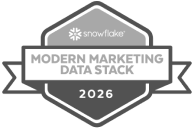Git for data tools bring familiar version control concepts from software engineering best practices (ie versioning, branching, and merging) to data management. Here's a comprehensive look at the leading solutions enabling data teams to work with the same rigor and confidence as software engineers.
What is Git for Data?
Git for data is the application of the Git version control system to manage and version control data sets. It enables data practitioners to track changes to data over time, collaborate, and maintain a single source of truth for data.
Some key benefits include the ability to synchronize data versions, isolated development and testing using branching, and the ability to revert to previous stable versions of data.
1. DVC
What is DVC:
Data Version Control (DVC) has become the de facto standard for ML teams seeking to version datasets and models alongside their code. It is machine learning’s version control standard. Built as an extension to Git, DVC maintains the familiar Git workflow while handling large files that would overwhelm traditional repositories. The tool stores actual data in cloud storage (S3, Azure Blob, GCS) or remote servers while keeping lightweight metadata pointers in Git.
Why choose DVC:
What makes DVC compelling is its tight integration with existing developer workflows. Data teams can use standard Git commands for code while DVC handles data artifacts transparently. The dvc push and dvc pull commands mirror Git's push/pull semantics and make the learning curve easier for teams already comfortable with version control.
DVC's pipeline feature defines reproducible ML workflows as code. Teams can version not just datasets and models but entire computational graphs showing how raw data transforms into predictions. This lineage becomes extremely helpful when debugging model performance issues or reproducing results from months-old experiments. DVC also integrates with CI/CD systems for automated testing and validation of data pipelines.
Who is it for:
Organizations with strong Git workflows find DVC natural because it extends familiar concepts (commits, branches, pull requests) to data assets. Data scientists comfortable with version control for code face a minimal learning curve. DVC is less ideal for enterprise data engineering teams managing petabyte-scale data lakes, organizations needing catalog-level versioning across thousands of tables, or teams requiring real-time streaming data versioning. For those use cases, tools like Nessie, Delta Lake, or Iceberg provide better architecture fits.
2. Project Nessie
What is Project Nessie:
Project Nessie takes a different architectural approach by providing Git semantics at the data catalog level rather than for individual files. This Apache project allows teams to create branches of entire data catalogs, experiment with schema changes across multiple tables, and merge validated changes back to production with atomic commit semantics.
Why choose Nessie:
Nessie particularly shines when paired with Apache Iceberg tables. While Iceberg provides table-level snapshots, Nessie adds catalog-level versioning that spans multiple tables. This enables multi-table transactions and consistent views across entire data warehouses. Teams can create a development branch, modify multiple interconnected tables, test downstream analytics, and merge everything atomically once validated.
The tool's branching model enables isolated development environments without data duplication. Multiple teams can work on different branches simultaneously (ie. one team optimizing transformations, another adding new data sources, a third experimenting with schema evolution) without interfering with production or each other. Branches are lightweight metadata operations which makes them fast and inexpensive regardless of underlying data volume.
Who is it for:
Nessie's REST API and integration with popular query engines (Spark, Flink, Dremio, Trino) make it accessible across the data stack. The catalog-level approach means changes to table schemas, metadata, and even catalog structure itself are all versioned together. Data teams can experiment with reorganizing their entire data catalog in a branch, test the impact on downstream consumers, and merge confidently.
3. Delta Lake
What is Delta Lake:
Delta Lake (built on Apache Parquet files) is an open-source storage layer that runs on top of existing data lakes to improve their reliability, performance, and manageability.
Why choose Delta Lake:
Delta Lake, while primarily a table format, includes powerful time travel capabilities that provide version control semantics without additional tools. Every Delta table maintains a transaction log recording all changes (inserts, updates, deletes, schema modifications) enabling queries against historical versions using simple SQL syntax.
The VERSION AS OF and TIMESTAMP AS OF clauses allow analysts to query data as it existed at any previous point. Particularly for debugging, teams can query the exact data state that existed when the issue occurred. Time travel also enables regulatory compliance by preserving historical records even as underlying data evolves.
Delta Lake's MERGE operation provides sophisticated upsert semantics with full versioning support. Teams can update slowly changing dimensions or apply CDC (Change Data Capture) streams while maintaining complete history. Combined with time travel, this enables both current-state and historical analytics from the same table.
Who is it for:
For organizations already using Delta Lake for ACID transactions and performance optimization, the built-in time travel provides version control capabilities without additional infrastructure. Databricks platform extends these features with Delta table clones.
4. Apache Iceberg
What is Apache Iceberg:
Apache Iceberg is an open table format designed to bring reliability, scalability, and version control to large datasets. Iceberg introduces snapshot management which is a mechanism that functions like version control for your data tables. Every write operation generates a new, immutable snapshot while older ones remain accessible, allowing teams to explore, audit, or roll back to previous table states without custom scripts or complex pipelines.
Why choose Iceberg:
Apache Iceberg provides sophisticated snapshot management that functions as a version control system at the table format level. Every write operation creates a new snapshot while previous snapshots remain accessible. The format's metadata layer tracks all table states, enabling time travel queries and rollback operations without custom tooling.
Iceberg snapshots are immutable and atomic meaning that either all changes in a transaction succeed or none do. This consistency guarantee prevents partial writes that could corrupt analytical results. Teams can reference specific snapshot IDs in queries, ensuring reproducible analytics even as tables continue evolving.
Who is it for:
Iceberg's compatibility with Project Nessie creates a powerful combination where Iceberg handles table-level snapshots while Nessie provides catalog-level version control. Together, they enable Git-like workflows across entire data platforms, bringing software engineering rigor to data management.
Choosing the Right Git-for-Data Tool
Selecting a version control solution depends on your specific workflow and infrastructure:
Choose DVC if your primary focus is ML experimentation and you want version control that integrates naturally with existing Git workflows and CI/CD pipelines.
Choose Nessie if you're building a lakehouse with Iceberg and need catalog-level version control with multi-table transactions and isolated development environments.
Choose Pachyderm if you're building complex data pipelines where versioning both data and transformations together is critical for reproducibility and compliance.
Choose Delta Lake time travel if you're already using Delta Lake and need historical query capabilities without additional infrastructure.
Choose Iceberg snapshots if you're adopting Iceberg tables and want sophisticated snapshot management with strong consistency guarantees.
Choose Git LFS if you're working with smaller datasets and want to extend your existing Git workflows without additional infrastructure.
Many organizations find success combining multiple approaches. This could look like: DVC for ML experiments, Nessie for production data lakes, and format-native versioning (Delta, Iceberg) for core analytical tables. The key is understanding where version control adds most value in your workflows: experiment tracking, data quality validation, regulatory compliance, or production rollback capabilities.
Learn more about Secoda
Secoda is your 24/7 data analyst. When paired with Secoda, teams can automatically document, catalog, and govern their Iceberg tables, ensuring that every schema change, lineage update, and query context is tracked and discoverable. This integration enhances collaboration across engineering, analytics, and governance teams by providing a single source of truth for both data and metadata, reducing the risk of “data drift” and making audits and reproducibility effortless.



.jpg)


.png)









